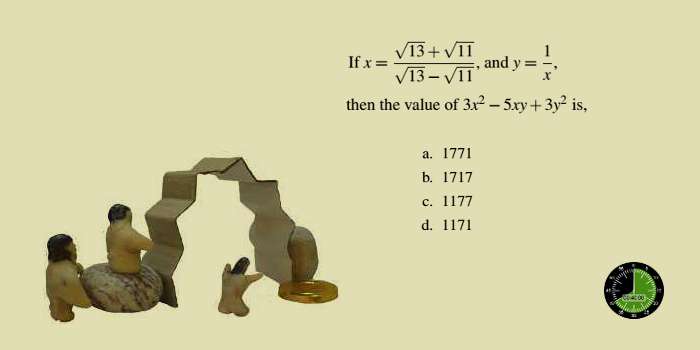Repeated componendo dividendo and principle of interaction of inverses speed up solution amazingly

The problem we have chosen this time is to highlight,
- Importance of recognition of simplifying powerful patterns inherent in a difficult problem,
- The power of Componendo dividendo to speed up solution considerably, and
- The unfailing effectiveness of principle of interaction of inverses if you can recognize its presence and apply it.
Let us showcase the problem and its solution.
Watch the all in mind lightning quick solution in the video below,
Solving difficult Surd algebra question in a few steps by Pattern identification and Componendo Dividendo
Problem example
If $x=\displaystyle\frac{\sqrt{13}+\sqrt{11}}{\sqrt{13}-\sqrt{11}}$, and $y=\displaystyle\frac{1}{x}$, then the value of $3x^2-5xy+3y^2$ is,
- 1771
- 1717
- 1177
- 1171
Solution: Problem analysis and identification of pattern of sum of inverses and componendo dividendo: Solving in mind
First we look at the given equation that involves awkward surds, but with the componendo dividendo signature pattern easily visible. We mentally map out how we would get rid of the surds.
Applying componendo dividendo once on the given equation will reduce the RHS to a ratio of single term surds. Just square it and we are free of troublesome surds. At this stage of initial problem analysis we are sure of our actions up to this point.
Now, turning our attention to the target expression, identification of the lightly hidden pattern of sum of inverses of squares was not difficult. Let us explain how we identify this powerful pattern.
Solution: Pattern identification technique for sum of inverses
As $y$ is inverse of $x$, and in the target expression the coefficients of $x^2$ and $y^2$ are equal with middle term effectively numeric, the expression can easily be transformed to a sum of squares of inverses. This is the identification technique for the pattern of sum of inverses.
More formally the identification technique for a pattern of sum (additive or subtractive) of inverses of any power is,
In an expression locate two terms in same variable having equal coefficients and difference in power of 2, or multiple of 2. The pair will be the candidates for easy transformation into a sum of inverses.
Example
$x^6+2x^5+3x^4+x^2+2x+3$
$=(x^6+x^2)+2(x^5+x)+3(x^4+1)$
$=x^4\left(x^2+\displaystyle\frac{1}{x^2}\right)+2x^3\left(x^2+\displaystyle\frac{1}{x^2}\right)+3x^2\left(x^2+\displaystyle\frac{1}{x^2}\right)$
Coming back to our problem, mark that by the Principle of interaction of inverses, once we encounter a sum inverses of squares, we know that we need just the value of sum of inverses to evaluate the sum of inverses of squares.
In other words, if we know value of $\left(x+\displaystyle\frac{1}{x}\right)$ we would always be able to evaluate $\left(x^2+\displaystyle\frac{1}{x^2}\right)$.
Solution: Converting the target expression to a sum of inverses of squares
The target expression,
$3x^2-5xy+3y^2$
$=3\left(x^2+\displaystyle\frac{1}{x^2}\right)-5$, as $y=\displaystyle\frac{1}{x}$.
This can be quickly evaluated by applying principle of interaction of inverses if we are able to transform the given expression in $x$ as a sum of inverses in $x$.
To achieve this objective, our first target would be to eliminate the square roots from the given value of $x$.
Solution: Eliminating the surds (or the square roots) from the given value of $x$
The given value of $x$ is componendo dividendo ready (pattern identification again), and so we will first carry out the three-step method in mind to get,
$\displaystyle\frac{x+1}{x-1}=\frac{\sqrt{13}}{\sqrt{11}}$.
Next step is obvious. We need to raise both sides of the equation to the power of 2 to get rid of the square roots,
$\displaystyle\frac{(x+1)^2}{(x-1)^2}=\frac{13}{11}$.
Solution: Using Rich Componendo dividendo pattern
Usual and most often encountered signature pattern of componendo dividendo is,
$\displaystyle\frac{x+1}{x-1}$.
In this case, we have square of this pattern, apparently not ready for componendo dividendo. This is where power of visualization helps us to see through the light veil.
Knowing how these two expressions in numerator and denominator interact when subtracted and when added, first assurance we get that for subtraction of denominator from numerator we will get just $4x$, a single term. Similarly for addition, the middle term of $2x$ cancels out leaving $2(x^2+1)$. On the whole it is significant simplification of the expression. So we go ahead with applying componendo dividendo for a second time.
Applying componendo dividendo again,
$\displaystyle\frac{x^2+1}{2x}=12$, it helped quick simplification this time,
Or, $x+\displaystyle\frac{1}{x}=24$, this is a bonus—perfect fulfillment of our expectation.
It has been possible to arrive at this point mentally without writing any step. Our objectives that we had set are met. Only one step remains.
Solution: Last stage of execution: Solution by using principle of interaction of inverses
The target expression is already in suitable form to apply principle of interaction of inverses. We just substitute the value of sum of inverses obtained.
Target expression,
$3x^2-5xy+3y^2$
$=3\left(x^2+\displaystyle\frac{1}{x^2}\right)-5$
$=3\left[\left(x+\displaystyle\frac{1}{x}\right)^2-2\right]-5$, by the use of principle of interaction of inverses
$=3(24^2-2)-5$
$=3\times{574}-5=1722-5=1717$.
Answer: Option b: 1717.
Problem analysis, effective strategy decision and pattern based power methods enable us to reach the solution wholly in mind.
By End state analysis approach, the patterns are identified and methods are used for the transformation of both the target expression and the given expression to move towards each other and meet for the solution in a few steps.
Key concepts used: Problem analysis -- Key pattern identification -- Pattern identification technique -- Strategy decision -- Repeated componendo dividendo -- End state analysis approach -- Target driven input transformation -- Principle of interaction of inverses -- Solving in mind -- Patterns and methods.
The list of Difficult algebra problem solving in a few steps quickly is available at, Quick algebra.
Guided help on Algebra in Suresolv
To get the best results out of the extensive range of articles of tutorials, questions and solutions on Algebra in Suresolv, follow the guide,
The guide list of articles includes ALL articles on Algebra in Suresolv and is up-to-date.
